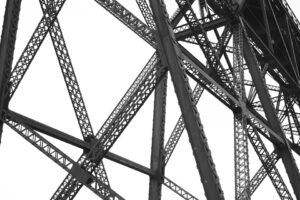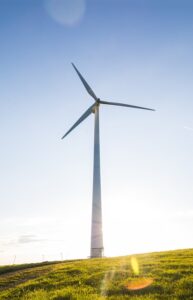Strain measurement is imperative during prototype design and testing. Strain measurements ensure that materials perform as they should and that the equipment is safe and durable. Measuring strain is crucial for testing complex structures, like aircraft, turbines, etc. There multiple ways in which stress can be measured. However, it is widely accepted that FBG sensors are the most efficient way of strain measurement. FBG sensors provide multiple advantages over other methods:
1) high sensitivity;
2) small size;
3) ability to be mounted on any surface;
4) immunity to electromagnetic interference;
5) reliability even in harsh environments;
6) low sensitivity to vibration and heat.
FBG strain sensors are used in wing load testing to determine the structure’s performance and possible limitations under the lifting forces during flight. There are several benefits that FBG strain sensors offer to the aerospace field for this type of application. For instance, FBG technology provides strain measurement using a big number of continuous sensors which ensures maximum coverage from a single optical fiber. The immunity to electromagnetic interference, radio frequency interference and other electrical influences makes FBG strain sensors ideal for use in hazardous environments, such as flight. Also, FBG sensors are less cumbersome to install. In addition, the FBG strain sensor prices are expected to decrease by 20% which will open up new opportunities for various markets.
The repeated loading and unloading of a material causes fatigue. It is estimated that around 90% of structural failures are a result of fatigue. To determine the breaking point of a structure, fatigue tests are performed. The tests indicate the number of loading cycles until failure. FBG sensors are able to provide real-time data on strain fields and load distributions. The immunity to both low and high temperatures enables the sensors to be monitored during the high-temperature cure phase of composite fabrication. The fatigue life of an FBG strain sensor far surpasses that of other methods of strain measurement.
The tendency to build longer wind turbines with longer blades complicates the maintenance. The design of stronger, lighter materials is necessary, however small imperfections during the manufacturing process can cause failures. FBG strain sensors may provide real-time knowledge of load distributions and turbine blade shape. This data will provide valuable information on the needed adjustments to the blades manufacturing.
Optromix, Inc. is a U.S. manufacturer of innovative fiber optic products for the global market, based in Cambridge, MA. Our team always strives to provide the most technologically advanced fiber optic solutions for our clients. Our main goal is to deliver the best quality fiber optic products to our clients. We produce a wide range of fiber optic devices, including our cutting-edge customized fiber optic Bragg grating product line and fiber Bragg grating sensor systems. Optromix, Inc. is a top choice among the manufacturers of fiber Bragg grating monitoring systems.
If you have any questions, please contact us at info@optromix.com


 Fiber Bragg gratings are often used in strain sensing especially in such places where the environment is harsh (for instance, high-EMI, high-temperature, or highly-corrosive). Strain measurement is imperative during prototype design and testing. Strain measurements ensure that materials perform as they should and that the equipment is safe and durable. Measuring strain is crucial for testing complex structures, like aircraft, turbines, etc. There various ways in which stress can be measured, but it is widely accepted that
Fiber Bragg gratings are often used in strain sensing especially in such places where the environment is harsh (for instance, high-EMI, high-temperature, or highly-corrosive). Strain measurement is imperative during prototype design and testing. Strain measurements ensure that materials perform as they should and that the equipment is safe and durable. Measuring strain is crucial for testing complex structures, like aircraft, turbines, etc. There various ways in which stress can be measured, but it is widely accepted that The increased demand for energy due to the growing population has forced the industry to develop new sustainable ways to produce energy. Among new and developing energy technologies are wind turbines. They are widely used to produce energy in many parts of the world. However, there are multiple concerns that are yet to be solved, one of them has been the lack of effective monitoring devices and techniques.
The increased demand for energy due to the growing population has forced the industry to develop new sustainable ways to produce energy. Among new and developing energy technologies are wind turbines. They are widely used to produce energy in many parts of the world. However, there are multiple concerns that are yet to be solved, one of them has been the lack of effective monitoring devices and techniques.  Strain measurement is imperative during prototype design and testing. Strain measurements ensure that materials perform as they should and that the equipment is safe and durable. Measuring strain is crucial for testing complex structures, like aircraft, turbines, etc. There are multiple ways in which stress can be measured; however, it is widely accepted that
Strain measurement is imperative during prototype design and testing. Strain measurements ensure that materials perform as they should and that the equipment is safe and durable. Measuring strain is crucial for testing complex structures, like aircraft, turbines, etc. There are multiple ways in which stress can be measured; however, it is widely accepted that All engineering infrastructures undergo aging. The damage that appears over time is a consequence of the loads applied to them, therefore regular maintenance actions are required in order to predict the lifetime of these structures and lengthen it, which, in turn, will aid in avoiding catastrophic failures. Aviation-related infrastructures demand the highest levels of damage detection as these structures are overwhelmingly built according to a damage-tolerant principle. The structures for aerospace are designed to withstand damages with certain characteristics. Damage-tolerant design involves considerable effort for structure inspection. The inspections and maintenance tasks need to be periodic and scheduled; these are essential for safe and efficient operations.
All engineering infrastructures undergo aging. The damage that appears over time is a consequence of the loads applied to them, therefore regular maintenance actions are required in order to predict the lifetime of these structures and lengthen it, which, in turn, will aid in avoiding catastrophic failures. Aviation-related infrastructures demand the highest levels of damage detection as these structures are overwhelmingly built according to a damage-tolerant principle. The structures for aerospace are designed to withstand damages with certain characteristics. Damage-tolerant design involves considerable effort for structure inspection. The inspections and maintenance tasks need to be periodic and scheduled; these are essential for safe and efficient operations.